
a.
To calculate: The linear regression models for the populations of both cities using the given data.
The obtained matrix is
Given Information:
The table is defined,
| Time (years) | Florida (thousands) | Indiana ( thousands) |
| 1980 | 9746 | 5490 |
| 1990 | 12938 | 5544 |
| 2000 | 15982 | 6080 |
| 2010 | 18801 | 6483 |
Calculation:
Consider the given table,
| Time (years) | Florida (thousands) | Indiana ( thousands) |
| 1980 | 9746 | 5490 |
| 1990 | 12938 | 5544 |
| 2000 | 15982 | 6080 |
| 2010 | 18801 | 6483 |
Use a graphing calculator to find the linear rgeression.
Step 1. Insert the table in calculator by using the table feature and take as 0 for 1980.
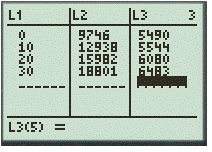
Step 2. Use the LinReg feature with first two list
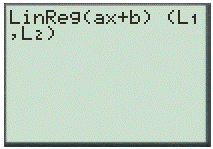
And,
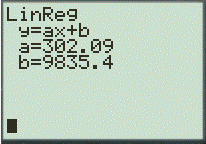
Therefore, the obtained equation is
b.
To calculate: The linear regression models for the populations of both cities using the given data.
The obtained model is
Given Information:
The table is defined as,
| Time (years) | Florida (thousands) | Indiana ( thousands) |
| 1980 | 9746 | 5490 |
| 1990 | 12938 | 5544 |
| 2000 | 15982 | 6080 |
| 2010 | 18801 | 6483 |
Calculation:
Consider the given table,
| Time (years) | Florida (thousands) | Indiana ( thousands) |
| 1980 | 9746 | 5490 |
| 1990 | 12938 | 5544 |
| 2000 | 15982 | 6080 |
| 2010 | 18801 | 6483 |
Use a graphing calculator to find the linear rgeression.
Step 1. Insert the table in calculator by using the table feature and take as 0 for 1980.
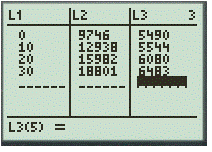
Step 2. Use the LinReg feature with first two list
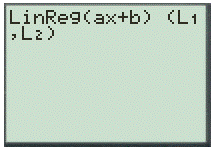
And,
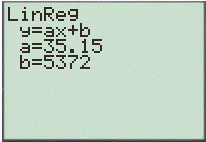
Therefore, the obtained equation is
c.
To calculate: The time when the populations of the two cities were the same as well as the common population of the two cities.
The obtained result is
Given Information:
The equations from the previous part is
Calculation:
Consider the given information,
Equate both the equations
Add the obtained value in 1980.
The corresponding year is 1963.
Now, substitute
Hence, the obtained result is
Chapter 7 Solutions
PRECALCULUS:GRAPHICAL,...-NASTA ED.
- Explain the key points and reasons for 12.8.2 (1) and 12.8.2 (2)arrow_forwardQ1: A slider in a machine moves along a fixed straight rod. Its distance x cm along the rod is given below for various values of the time. Find the velocity and acceleration of the slider when t = 0.3 seconds. t(seconds) x(cm) 0 0.1 0.2 0.3 0.4 0.5 0.6 30.13 31.62 32.87 33.64 33.95 33.81 33.24 Q2: Using the Runge-Kutta method of fourth order, solve for y atr = 1.2, From dy_2xy +et = dx x²+xc* Take h=0.2. given x = 1, y = 0 Q3:Approximate the solution of the following equation using finite difference method. ly -(1-y= y = x), y(1) = 2 and y(3) = −1 On the interval (1≤x≤3).(taking h=0.5).arrow_forwardConsider the function f(x) = x²-1. (a) Find the instantaneous rate of change of f(x) at x=1 using the definition of the derivative. Show all your steps clearly. (b) Sketch the graph of f(x) around x = 1. Draw the secant line passing through the points on the graph where x 1 and x-> 1+h (for a small positive value of h, illustrate conceptually). Then, draw the tangent line to the graph at x=1. Explain how the slope of the tangent line relates to the value you found in part (a). (c) In a few sentences, explain what the instantaneous rate of change of f(x) at x = 1 represents in the context of the graph of f(x). How does the rate of change of this function vary at different points?arrow_forward
- 1. The graph of ƒ is given. Use the graph to evaluate each of the following values. If a value does not exist, state that fact. и (a) f'(-5) (b) f'(-3) (c) f'(0) (d) f'(5) 2. Find an equation of the tangent line to the graph of y = g(x) at x = 5 if g(5) = −3 and g'(5) = 4. - 3. If an equation of the tangent line to the graph of y = f(x) at the point where x 2 is y = 4x — 5, find ƒ(2) and f'(2).arrow_forwardDoes the series converge or divergearrow_forwardDoes the series converge or divergearrow_forward
- Diverge or converarrow_forwardCan you help explain what I did based on partial fractions decomposition?arrow_forwardSuppose that a particle moves along a straight line with velocity v (t) = 62t, where 0 < t <3 (v(t) in meters per second, t in seconds). Find the displacement d (t) at time t and the displacement up to t = 3. d(t) ds = ["v (s) da = { The displacement up to t = 3 is d(3)- meters.arrow_forward
- Let f (x) = x², a 3, and b = = 4. Answer exactly. a. Find the average value fave of f between a and b. fave b. Find a point c where f (c) = fave. Enter only one of the possible values for c. c=arrow_forwardplease do Q3arrow_forwardUse the properties of logarithms, given that In(2) = 0.6931 and In(3) = 1.0986, to approximate the logarithm. Use a calculator to confirm your approximations. (Round your answers to four decimal places.) (a) In(0.75) (b) In(24) (c) In(18) 1 (d) In ≈ 2 72arrow_forward
 Calculus: Early TranscendentalsCalculusISBN:9781285741550Author:James StewartPublisher:Cengage Learning
Calculus: Early TranscendentalsCalculusISBN:9781285741550Author:James StewartPublisher:Cengage Learning Thomas' Calculus (14th Edition)CalculusISBN:9780134438986Author:Joel R. Hass, Christopher E. Heil, Maurice D. WeirPublisher:PEARSON
Thomas' Calculus (14th Edition)CalculusISBN:9780134438986Author:Joel R. Hass, Christopher E. Heil, Maurice D. WeirPublisher:PEARSON Calculus: Early Transcendentals (3rd Edition)CalculusISBN:9780134763644Author:William L. Briggs, Lyle Cochran, Bernard Gillett, Eric SchulzPublisher:PEARSON
Calculus: Early Transcendentals (3rd Edition)CalculusISBN:9780134763644Author:William L. Briggs, Lyle Cochran, Bernard Gillett, Eric SchulzPublisher:PEARSON Calculus: Early TranscendentalsCalculusISBN:9781319050740Author:Jon Rogawski, Colin Adams, Robert FranzosaPublisher:W. H. Freeman
Calculus: Early TranscendentalsCalculusISBN:9781319050740Author:Jon Rogawski, Colin Adams, Robert FranzosaPublisher:W. H. Freeman
 Calculus: Early Transcendental FunctionsCalculusISBN:9781337552516Author:Ron Larson, Bruce H. EdwardsPublisher:Cengage Learning
Calculus: Early Transcendental FunctionsCalculusISBN:9781337552516Author:Ron Larson, Bruce H. EdwardsPublisher:Cengage Learning





